When you begin learning SEO, you will soon come to realise there are many different facets that you need to understand to succeed.
From on-page SEO to on-page SEO and content creation. You need to have a firm grasp of it all, no matter your specific role within SEO, to get your website ranking where it needs to be.
In this article, we will explore technical SEO. You will learn exactly what it is, why it is important for websites, and the traits of a website that is well-optimised from a technical point of view.
We'll also give you the "lowdown" on how technical SEO works, from crawling and indexing to ranking and what you need to get these three steps working together well.
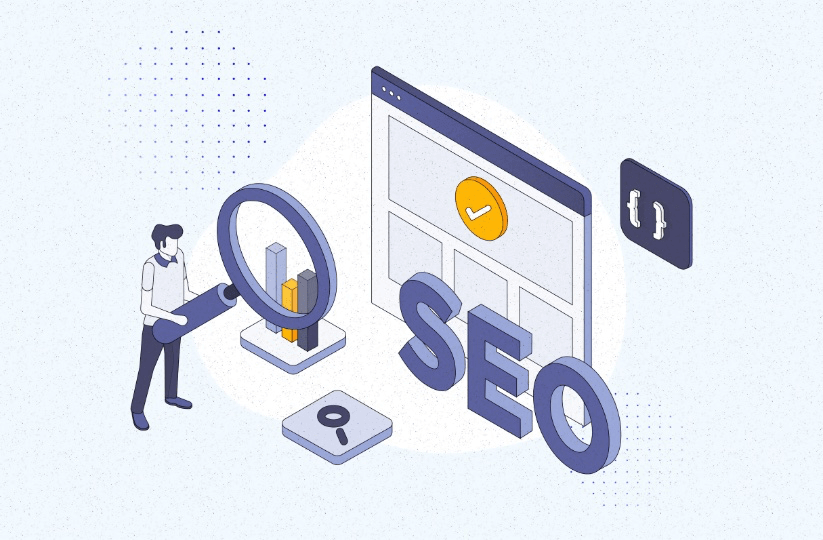
What is Technical SEO?
Technical SEO is the process of optimising a website's "behind the scenes" elements to improve its performance on search engines like Google and Bing. This process includes steps such as enhancing the website's markup and structure to ensure easy crawling, indexing and ranking (we will talk more about this later) by search engine bots like Googlebot. Tasks encompass refining website speed, creating a simple and easy-to-understand site architecture, using "SEO-friendly" URLs, and applying schema markup for enriched search results.
Essentially, technical SEO creates a strong base that aids search engines in the process of elevating a website's rankings. This will ultimately lead to increased organic traffic and an enhanced user experience.
Think of your website as a well-organised library. Technical SEO is the step of neatly shelving books with clear tags (your URL structure), setting up signs for smooth navigation (your internal links), and creating a welcoming ambience (site speed). When the library is orderly and inviting, more visitors can locate the books they need (users discovering content) and librarians (search engine bots) can categorise and suggest books (indexing and ranking).
Why is Technical SEO Important?
Technical SEO is incredibly important to the vast majority of websites as it forms the bedrock for the website's search engine visibility and overall performance. Of course, the content you publish is crucial, but lacking proper technical optimisation could stop search engines from effectively discovering, indexing and ranking that content.
The significance of technical SEO can be summarised as follows:
Firstly, it ensures that search engines can effectively crawl and index your content. By optimising elements such as your website structure and navigation, technical SEO facilitates the smooth crawling of your website by search engine bots. This accessibility is vital to ensuring your content gets noticed and indexed appropriately.
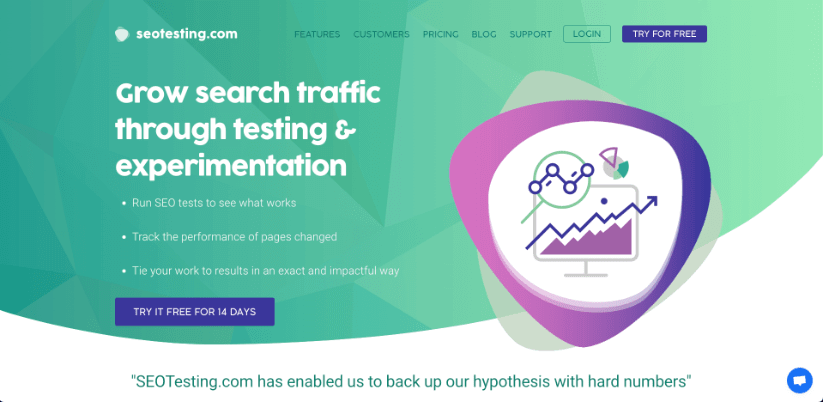
We might be a little biased, but we believe our website is a great example of a site that has great architecture!
Secondly, technical SEO directly influences your search engine rankings. Website speed and mobile responsiveness are confirmed ranking factors within Google's search algorithm, and beyond that, having well-structured HTML markup plays a vital role in how search engines evaluate your website's quality and relevance. A well-optimised website is more likely to rank higher in search engines.
Finally, technical SEO contributes to your website having a great user experience. While you are working on your technical SEO, practices like optimising page load times and improving URLs will also enhance user satisfaction. An improved user experience leads to reduced bounce rates and heightened engagement rates, which will indirectly improve your website's performance in search.
Ultimately, technical SEO serves as the cornerstone on which effective SEO strategies are built! This guarantees that your content is not only top-notch but is also discoverable and accessible. This will appeal to both search engines and, more importantly, users.
What are the Traits of a Technically Optimised Website?
No matter the website, whether it is an ecommerce website doing millions of pounds in revenue, or a brochure website showcasing the services for a local plumbing company, all websites have the same traits when it comes to being well-optimised from a technical SEO standpoint.
It's Fast
A well-optimised website will load quickly across all devices (desktop, tablet and mobile) and network conditions. Fast-loading pages enhance the experience a user has on your website and are favoured by search engines, potentially leading to higher rankings.
We know that Google lists passing core web vitals tests as a confirmed ranking factor, which is rare for them, so ensuring your website is quick and passes CWV tests is crucial.
It's Crawlable
This should be a no-brainer, but websites should be crawlable by search engines. If a search engine bot (like Googlebot) cannot crawl your website effectively, you are going to find issues with your page ranking on the SERPs.
Robots.txt files and meta robots tags should be properly configured. This will help guide search engine bots on which pages to crawl and index, and which pages to leave alone. Not every page on your website should be crawled. Especially admin pages and pages containing customer data.
It Preserves Link Equity
Websites that are well-optimised technically do everything they can to preserve as much link equity as possible.
Firstly, the website will use internal links that guide users (and search engine bots) to relevant content within the site. This improves website navigation, helps distribute link equity to other pages, and keeps users on the website longer.
Secondly, the website will be completely free (ideally) of broken links and unnecessary redirect chains. This ensures a seamless user experience and efficient crawling by search engines.
Pro Tip: You can use ScreamingFrog to identify broken links and redirect chains that don't need to be there.
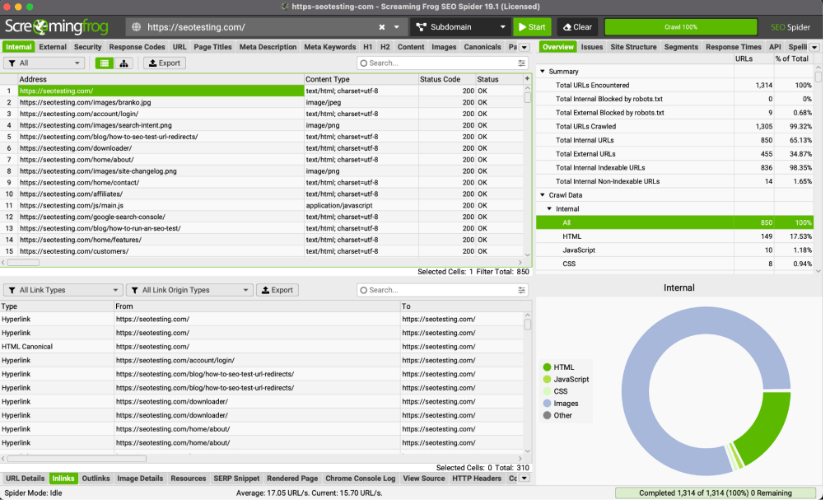
It's Mobile-Friendly
All websites should be designed to be responsive and functional on mobile devices. With the ever-increasing use of smartphones for browsing (as of 2023, 63% of Google's US organic search traffic originates from mobile devices), mobile-friendliness is a crucial factor in both user experience and rankings.
It's Secure
All websites should ensure their website use the secure HTTPS protocol.
What this does is ensure that your website has adequate data encryption in place, and will boost the trust that users have when using your website. This trust is especially important when financial data is being handed over on websites, such as credit card information.
Google has also confirmed that the use of the HTTPS protocol is a ranking factor. We do not know what weight the algorithm places on this, but we can guess that this is more of a factor when dealing with YMYL (Your Money Your Life) websites.
It Uses Structured Data
Schema markup is implemented on websites to provide additional context about the content. This will enable search engines to display rich snippets within the SERPs when showing your website, enhancing click-through rates and bringing more traffic through to your site.
Crawling
We covered this subject briefly in our article on how to learn SEO in 2023, but we will now go through the four stages within technical SEO that take your website from pages of HTML, CSS and JavaScript to rankings on the SERP. Crawling, rendering, indexing and ranking.
The first step in this journey is crawling.
Crawling refers to the process by which search engines like Google and Bing systematically browse and learn more about the content of websites on the internet. The goal of crawling is to gather information about web pages, this includes:
- Their content.
- Their structure.
- Other relevant information.
Search engines can then use this data to effectively index and rank (we will talk about this later) and display your web pages within SERPs.
Search engines use bots, called crawlers, to navigate through the huge amount of web pages online. The crawlers start by visiting a few well-known web pages, often popular or frequently updated pages. From there, they follow the links found on these pages to 'discover' new pages that they can then render, index and rank.
XML Sitemap
An XML sitemap is a file that gives search engines a structured list of all the URLs on your website. It's a tool that helps search engine crawlers understand the organisation of your website's content and ensures that they can discover and index all of your important pages effectively.
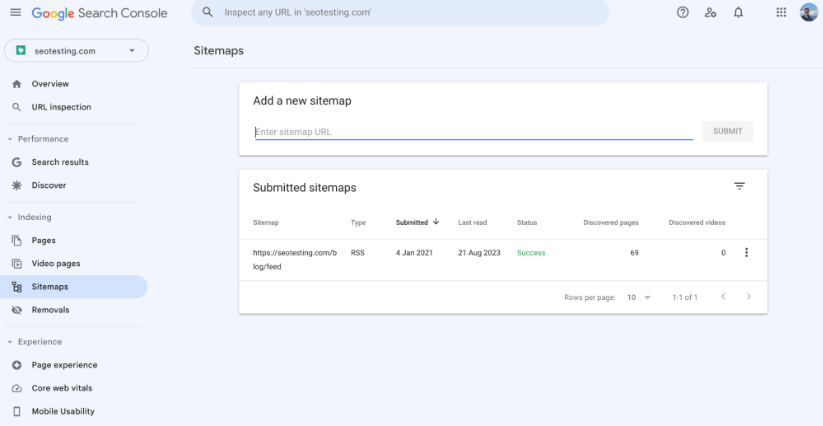
Ensuring you have an XML sitemap on your website is essential when it comes to your technical SEO as it helps get your pages crawled in several different ways:
Having an XML sitemap on your site provides search engine bots with a centralised list of URLs that you would like them to crawl and index. This will help you ensure that all of your essential pages, like product listing pages and product display pages, are included in search engine indexes and, hopefully, search engine results pages.
You can also use your sitemap to specify the priority and change the frequency of each URL on your site. It's important to note that search engines might not follow these rules exactly, but doing this can give crawlers an idea of the importance of different pages on your website and how often they are updated.
Whilst search engines use various factors to decide which pages to crawl and index first, your sitemap can help highlight important (or newly updated) pages. This can guide search engine bots to these pages and can help get them crawled and indexed quickly. If you didn't have a sitemap in place, you would be relying on crawlers to find these pages automatically, through the use of internal and external links etc. Which is a much longer process.
Large sites, with hundreds of thousands (or even millions of URLs), sitemaps (and multiple sitemaps) will help crawlers discover every page you want indexing more efficiently. This is a great thing to do as it helps you manage your crawl budget much more efficiently. This is not an issue for smaller websites as these small sites will have no issues with their crawl budget.
Site Structure
The structure of your website will play a crucial role in determining how search engine bots navigate and index its content. A well-organised site structure will not only facilitate efficient crawling by search engine bots but will also enhance the overall experience that real-life users have on your website.

Here is an example of an ecommerce website with a good site structure. All of the important pages (product listing pages) in this example are easily accessed from the Homepage navigation bar, passing on as much link equity as possible to these pages, and ensuring crawlers can easily find them.
When pages are organised into simple, easy-to-understand categories and subcategories, it becomes much easier for crawlers to follow links and index content systematically. This hierarchical arrangement ensures that crucial pages are closer to the homepage, increasing their chances of being discovered and indexed quickly.
Internal linking within a website's structure will guide search engine crawlers through different sections of your site more effectively. Well-placed and relevant internal links help distribute link equity across pages, allowing crawlers to uncover a much broader range of content than they could without internal links being placed throughout your content.
Orphan pages (pages with no links pointing to them) should be avoided as they present a huge challenge for crawlers. A robust site structure, with proper internal linking, avoids this.
Overall, the structure of your website will serve as a crucial framework that shapes how search engines crawl and index your content. By implementing a clear site hierarchy, adding relevant contextual links and optimising for crawl budget allocation (if required), website owners and marketers can positively influence how search engines crawl their websites.
URL Structure
Your website's URL structure will have a direct impact on the crawling of your website. Ensuring you have a well-organised (and descriptive) URL structure will enhance the efficiency of crawlers in understanding the content of each page. Clear (and short) URLs provide valuable context about the topic and hierarchy of the page's location within the website.
For example, a URL looking like: https://example.com/blog/head-topic-1 will tell a search engine crawler that this page is an essential page within the blog, about one of the website's key topics.
On the other hand, URLs that are convoluted or nonsensical (a good example is https://example.com/12642/test-category/test-page125253/) can confuse crawlers when they are navigating your website. This will hinder their ability to interpret the content, as well as the relevance and importance of the page within your website. A clean URL structure, with no unnecessary parameters and symbols, will increase the chances of your pages being crawled effectively.
Additionally, although not directly related to crawling, your URL structure will have a direct impact on your website's user experience and click-through rates. A concise and relevant URL is much, much more likely to attract user clicks in search results, which can (indirectly) impact your website's overall search engine ranking.
Robots.txt Files
Your robots.txt file holds a tremendous amount of power over how search engines navigate and crawl your website. This document, situated at the core of your site, details guidelines to search engine crawlers, dictating how your website should be crawled. Including which pages can be crawled and which pages should be left alone.
It's worth noting at this stage that, whilst your robots.txt file can halt crawlers' entry to specific pages or sections of your website, it does not guarantee that your pages will not be crawled via alternative avenues. Some search engines may still register pages that are excluded from crawling if they are found via other ways, for example, internal links on your site.
If your robots.txt file is riddled with errors or rigid rules, you may find this obstructs search engines from crawling important content, which can "cast a shadow" on your website's performance in the SERPs. It's important to keep a regular eye on your robots.txt file to ensure all the rules are working correctly.
Log File Analysis
Analysing your website's log files can have a huge impact on how search engines crawl your website, and this is something that marketers can do themselves with the right tools! Log files are, essentially, records that show which parts of your website search engines visit and how often search engine crawlers visit these parts of your website. Essentially, this allows you to determine which pages on your website are seen as important by search engines, allowing you to use this to gain an advantage.
This helps marketers decide which pages are worth spending more time (and potentially money on), making sure search engines pay attention to the right stuff. Also, log file analysis can show if search engines are finding your website easy to understand and navigate, or if they are having trouble. This can guide changes, like fixing how pages are connected (through internal linking, generally) or organising web addresses better.
One of my favourite talks on this is from Matthew Barby, from back in 2018 when he was VP of Organic Growth at HubSpot, find the exact segment of the talk at 25:07:
Rendering
Rendering refers to the process of how search engines analyse and understand the content and structure of your website, to determine its ranking on the SERPs. This process involves two main steps, crawling (which we have covered) and indexing (which we will talk about soon).
During crawling, search engine bots traverse the web, visiting web pages and collecting HTML data. However, not all content is immediately visible in the HTML markup. This is where rendering comes into play.
Rendering goes beyond basic HTML parsing, taking into account the dynamic elements often featured on modern websites that might not be visible in the raw HTML. This includes content loaded through JavaScript, AJAX or other scripting languages, as well as the page's CSS stylesheet. Search engine bots, in their attempt to simulate user experience, execute JavaScript and gather the fully rendered content/ This content is then used to build an index, a database of information about the web page.
For optimal SEO results, it is crucial to ensure that your website is easily renderable by search engine bots. This involves using techniques like server-side rendering (SSR) or pre-rendering for JavaScript-heavy websites. Providing metadata (like meta tags and descriptions) will help search engines understand the context and meaning of the content. Properly handling canonical tags and managing redirects is also important to prevent duplicate content issues.
Indexing
Indexing refers to the process of collecting, organising and storing information about web pages so they can be retrieved quickly and displayed in search results when a user searches a relevant query. Once a web crawler has crawled a web page and rendered its content, the information is added to the search engine's index.
The index, essentially, is a huge database that contains information about website content and the structure of web pages across the internet. Having access to this vast database of information allows search engines to quickly respond to user queries by finding relevant pages from the index and displaying them in the SERPs.
During the indexation process, search engines extract key information from the crawled and rendered web pages, such as content, metadata, images, and links. This information is then stored in a structured manner, which enables search engines to match user queries with relevant pages quickly.
There are a few things you should be looking to do, to help get your pages indexed efficiently.
Address Duplicate Content & Keyword Cannibalization Issues
Addressing duplicate content and keyword cannibalization issues will offer significant benefits when it comes to getting your pages indexed quickly.
By getting rid of duplicate content, you prevent any confusion for search engines, allowing you to identify the primary version of your content accurately.
What's more, resolving keyword cannibalization issues - where multiple pages target the same keywords - provides clear signals to search engines about the focus of each page. This clarity helps with efficient indexing and ranking, as search engines can understand the exact purpose of all your pages.
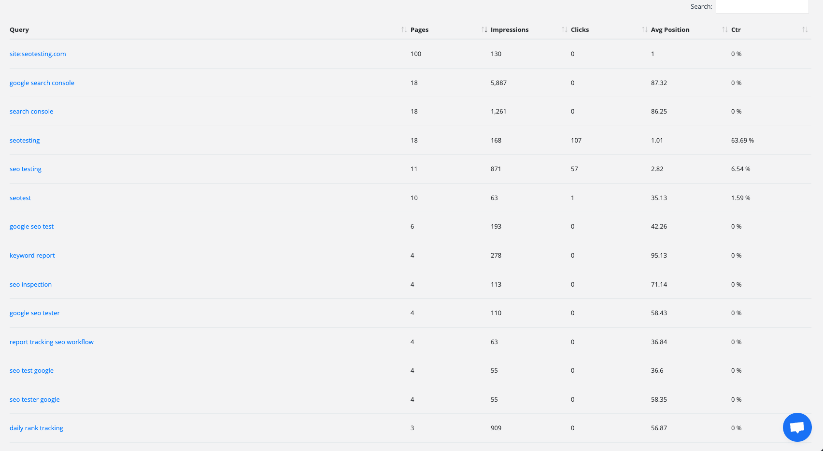
An image showing the Keyword Cannibalization Report within SEOTesting. This report can help you quickly identify and fix any keyword cannibalization issues on your website.
Optimising metadata (such as your title tags and meta descriptions) as well as adjusting internal linking structures will also help contribute to quick and easy indexing. These actions, when done correctly, guide search engines to the most relevant and important pages.
Additionally, consolidating content and avoiding keyword cannibalization will concentrate your content's authority onto a single page. This will result in higher page authority, encouraging search engines to prioritise and rank that authoritative page more prominently in the SERPs.
Audit Redirects
Examining how your website's redirects work can help improve how quickly search engines index your content. It can also help enhance your website's performance overall. Redirects act like markets, guiding both users and search engines to different pages when needed. If not managed well, they can slow down the indexation process, or stop pages from being indexed altogether. By performing a "redirect audit", you can enhance indexing in several meaningful ways.
Firstly, addressing excessive redirects will help search engines work more effectively when indexing your website At times, they may encounter multiple redirects, which can slow down their indexing of your content. By finding and removing unnecessary redirects, you can help search engines access your content quickly, giving them a better chance at being indexed (and therefore ranked) quickly too.
Completing a redirect audit will also allow you to tackle a common technical SEO problem. Redirect chains. Such chains can happen when one redirect leads to another, which leads to another, which leads to another, and so on. They can confuse search engines and consume too much of their time. We know when a search engine bot takes too long trying to index a page, it will move on and not index that page. An audit will allow you to find and fix these chains, enabling search engines to reach your content without issue.
Finally, an audit like this will help search engines accurately understand your website. When redirects are well-structured, search engines can better interpret the importance of your content. When search engines better understand your content importance, your important pages have a better chance of being indexed quickly.
Fix HTTP & HTTPS Errors
Fixing HTTP and HTTPS errors is vital for ensuring your pages are indexed properly. When search engine bots encounter these types of errors, they have a hard time accessing and understanding your content. When a search engine bot cannot access or understand your content, it cannot index it.
Addressing these issues improves indexing in the following ways:
Firstly, resolving HTTP errors like "404 Not Found" ensures that your pages are accessible to both users and search engines. When pages return these errors, search engines will interpret them as missing content, leading to exclusion from search results. Fixing these errors, gives crawlers a "clear path" to index your content, increasing the chances of getting them indexed and ranked.
Secondly, transitioning from HTTP to HTTPS is crucial for security and indexing. Search engines heavily prioritise secure websites (HTTPS) over non-secure websites (HTTP) in their ranking algorithms. Google even confirmed this! By migrating to HTTPS and ensuring a secure browsing experience for users, you enhance your site's credibility, indirectly improving its ability to be indexed and ranked.
Lastly, consistent HTTPS implementation and resolving HTTPS-related errors prevent users and search engines from encountering "mixed content" issues. Mixed content occurs when secure and non-secure elements are loaded on the same page. This could potentially cause security warnings and negatively impact user experience.
In essence, addressing HTTP and HTTPS errors removes barriers that hinder search engines from accessing and understanding your content. This highly proactive approach optimises the indexing process, increases visibility in search results and enhances the user experience on your site.
Look at your "Page Indexing Report" in Google Search Console
Google Search Console is a goldmine for assessing how your content is being indexed. Within your Page Indexing Report, you will be able to see every single page on your website that has not been indexed. You will also be able to see the reason that the page has not been indexed.
Here's an example:
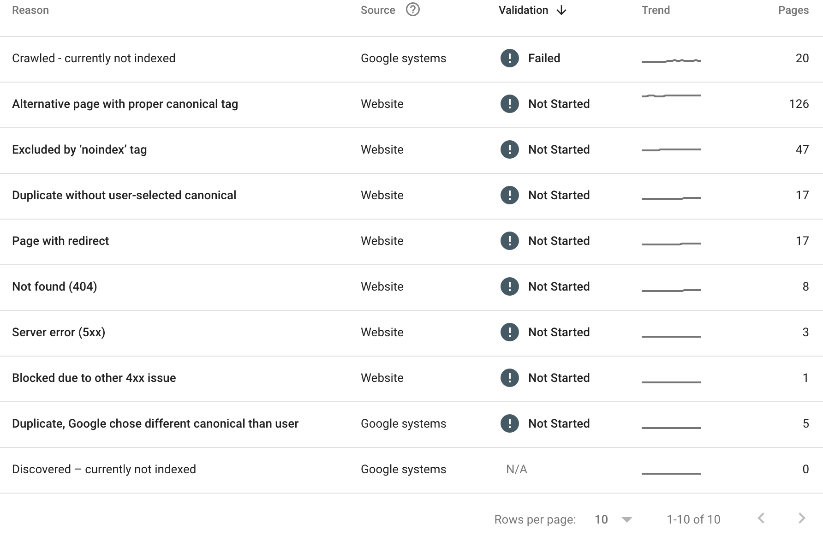
In the above (SEOTesting's Page Indexing Report), we can see that:
- 20 pages have been crawled but are not currently indexed.
- 126 pages have a proper canonical tag.
- 47 pages have been excluded by the 'noindex' tag.
- 17 pages are found to have been duplicates, with no user-selected canonical.
- 17 pages have a redirect in place.
- 8 pages have returned a 404 error.
- 3 pages have returned a 5xx server error.
- 1 page has been blocked due to another 4xx issue.
- 5 pages have been found as duplicates, and Google has chosen a different canonical.
Not all of the above reasons are issues, but it is worth it for us, as a marketing team, to find out why certain pages have not been indexed and fix as many of these issues as we can.
Ranking
Search engine ranking is the culmination of the crawling, rendering and indexing processes, where search engines determine the order in which web pages appear in SERPs. The goal is to present users with the most relevant and valuable content, based on their search queries.
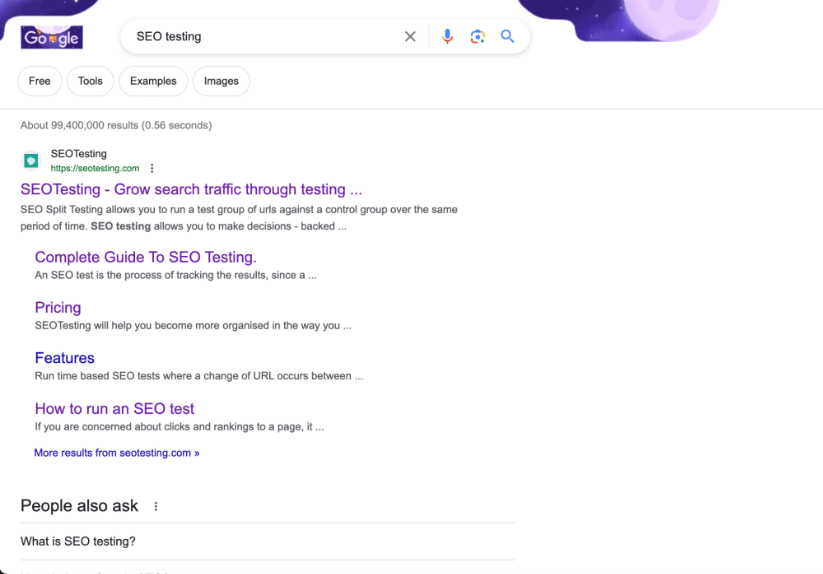
At its core, ranking relies on complex algorithms that assess a variety of factors to determine a web page's relevance and authority. One of the fundamental aspects is keyword relevance - how well the content matches the words and phrases users enter in their searches. Pages with high keyword relevance tend to rank better.
Keyword relevance alone is not sufficient, however. Search engines also consider the quality and authority of the website. Backlinks from reputable, authoritative and relevant (this is crucial), sites are a strong indicator of a page's credibility. The more high-quality backlinks a page has, the more likely it is to rank higher.
The experience users are having on your website also plays a huge role in ranking. Pages that load quickly, are mobile-friendly, and provide a smooth browsing experience for the user are heavily favoured by search engines. Engaging and valuable content that keeps users on your site, browsing, for longer also signals to search engines that your website might be worth ranking higher.
Personalisation is another aspect of ranking. Search engines will take into account the user's location, search history and preferences to tailor search results, to give the user the best experience possible. This means that the same query will most likely yield different results for different users.
It's important to remember that, no matter what other blog posts mention, we do not know what weight Google (and other search engines) places on different factors for different queries. For one question, you may have to rely more heavily on authoritative and relevant backlinks. For another, you may need to ensure your user experience is spot on. This all comes down to time in the industry, learning the algorithm and improving as you go.
Understanding diverse SEO aspects is vital to success in the SERPs. This article explored technical SEO's importance, the traits of optimised sites, and the mechanics of technical SEO from crawling to ranking.
Technical SEO builds a strong base for your website, optimising elements for better speed and structure. This improves navigation, content understanding and user experience.
In short, technical SEO is key. By fixing errors and optimising site structure, you will be able to enhance your online presence.
Want to supercharge your use of Google Search Console and take your SEO to the next level by implementing SEO testing into your routine? Give SEOTesting a try. We're currently running a 14-day free trial, with no credit card required to sign up. Give the tool a try today, and let us know what you think!

